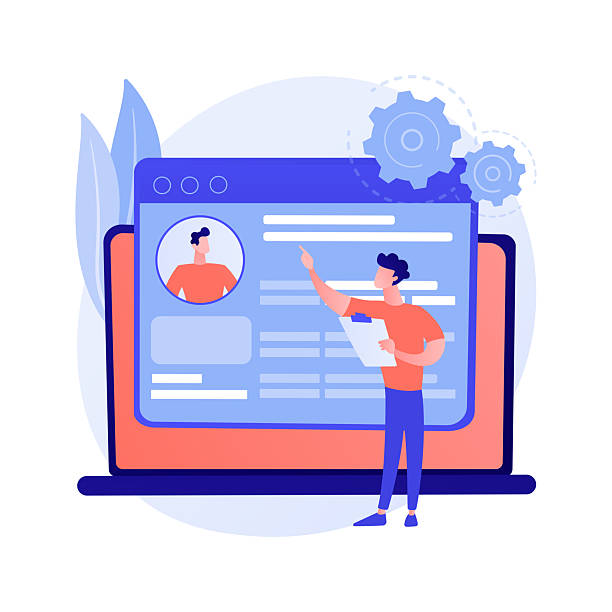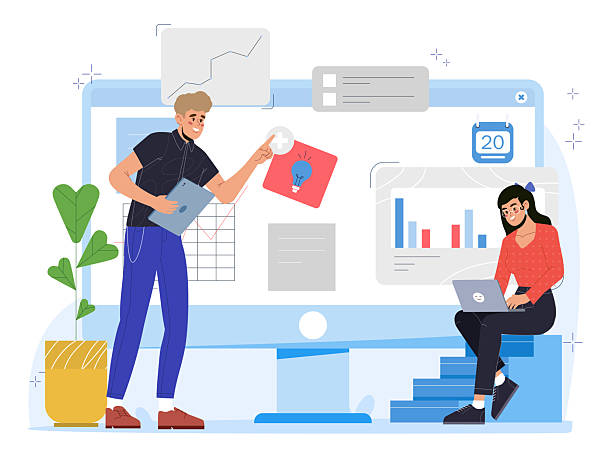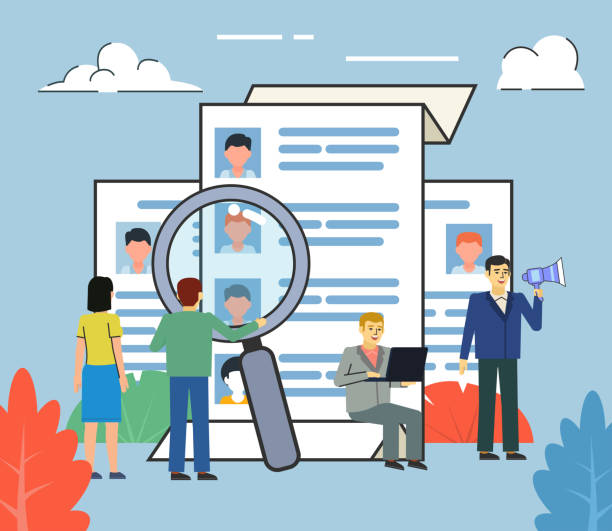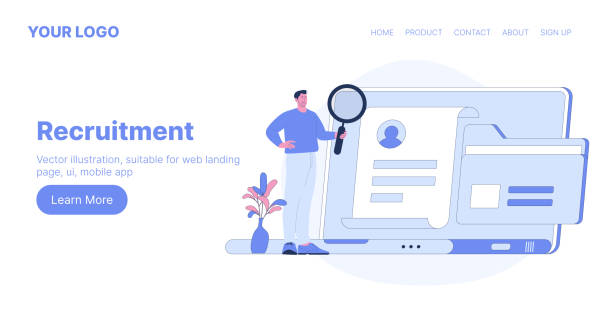Introduction to Fast Website Design: Why Speed Matters?

In today’s digital world, where users expect everything to be instantly accessible, website speed is no longer a luxury; it’s a necessity.
Fast website design not only improves user experience but also directly impacts your site’s search engine ranking and visitor conversion rates.
A slow website can quickly frustrate users and drive them towards competitors.
Long loading times, even just a few extra seconds, can mean losing a significant percentage of visitors.
This issue is particularly critical for online businesses, where every small delay can translate into reduced revenue.
Many studies have shown that users expect a web page to load in less than three seconds, and if this time is exceeded, the likelihood of abandoning the site increases sharply.
Therefore, investing in website speed optimization and achieving fast website design is one of the most important steps for the success of any online project.
This is an investment that will yield significant returns.
Are you tired of losing business opportunities due to not having a professional corporate website?
Rasaweb helps you with professional corporate website design to:
✅ Build a powerful and reliable brand image for yourself
✅ Convert website visitors into loyal customers
⚡ Get a free consultation now!
Key Factors Affecting Website Loading Speed

The loading speed of a website is influenced by numerous factors, and understanding and optimizing them are essential for achieving fast website design.
One of the most important of these factors is the size of images and multimedia files.
Large images without proper compression can significantly reduce loading speed.
Another factor is the quality of coding and the optimization of HTML, CSS, and JavaScript codes.
Extra, unnecessary, or redundant codes can slow down loading.
The type and quality of hosting also play a vital role.
Inappropriate hosting or a slow server can nullify your optimization efforts.
Using a CDN (Content Delivery Network) can also dramatically increase speed by distributing content from the closest server to the user.
Furthermore, the number of HTTP requests that the browser sends to load a page also affects speed.
The fewer these requests, the faster the loading will be.
Server-side and client-side caching settings also significantly help reduce loading time for repeated visits.
All these factors together determine your website’s final speed and must be carefully reviewed and optimized for rapid web development.
Website Speed Measurement and Improvement Tools: Step-by-Step

To achieve fast website design, you must first assess your website’s current status.
Numerous tools are available for this purpose, providing precise information on your site’s speed strengths and weaknesses.
Among the most popular are Google PageSpeed Insights, GTmetrix, and Pingdom Tools.
These tools analyze your site’s code, images, scripts, and server, providing comprehensive reports including loading time, page size, and suggestions for improvement.
After identifying issues, it’s time to implement optimization solutions.
These solutions include image compression, minification of CSS and JavaScript files, enabling browser caching, using Gzip compression, and database optimization.
Additionally, choosing an efficient Content Management System (CMS) and optimized templates is crucial in this process.
Increasing loading speed requires a continuous, step-by-step approach.
Below is a guide table for measurement tools and general solutions:
| Speed Measurement Tool | Strengths | General Solution |
|---|---|---|
| Google PageSpeed Insights | Scoring based on Google’s criteria, focus on mobile user experience | Image compression, elimination of render-blocking resources |
| GTmetrix | Detailed reports, waterfall chart of requests, comprehensive review of speed factors | JavaScript and CSS optimization, caching implementation |
| Pingdom Tools | Testing from various geographical locations, showing load time for each element | Reducing HTTP requests, using a CDN |
By using these tools and implementing their suggestions, you can continuously improve your website’s speed and ensure that fast website design is maintained in all aspects.
Optimizing Images and Media for Enhanced Performance

One of the biggest obstacles to fast website design is large image and media files.
These files usually constitute a significant portion of the total page size and take a long time to load.
To solve this problem, several specialized solutions exist.
The first step is to compress images without significant loss of quality.
New formats like WebP, developed by Google, can dramatically reduce image file sizes while preserving visual quality.
Additionally, using online tools or CMS plugins for automatic image compression during upload is highly recommended.
Another important point is choosing the correct dimensions for images.
An image displayed on the site should not be larger than the actual required dimensions.
Using `srcset` and `sizes` attributes in HTML allows the browser to load the appropriate image for the user’s screen size, which is especially crucial for Responsive Design.
Lazy loading is also an efficient technique where images and videos are only loaded when the user scrolls to the relevant section of the page.
This method prevents simultaneous loading of all media and contributes to the initial page speed.
By implementing these solutions, a significant impact can be made on website speed optimization and user experience.
Does your company’s website create a professional and lasting first impression on potential customers? Rasaweb, with its professional corporate website design, not only represents your brand’s credibility but also opens a path for your business growth.
✅ Create a powerful and reliable brand image
✅ Attract target customers and increase sales
⚡ Get a free consultation
The Importance of Code Optimization and Caching

Optimizing HTML, CSS, and JavaScript codes forms the backbone of a fast website design.
Clean, compressed codes without unnecessary errors increase browser processing speed.
The minification process removes whitespace, comments, and unnecessary characters from programming codes, leading to reduced file sizes and consequently faster loading.
Merging CSS and JavaScript files can also help reduce the number of HTTP requests.
In addition to code optimization, the concept of caching plays a pivotal role in increasing website speed.
Caching means temporarily storing copies of website content on the server side or in the user’s browser.
By enabling browser caching, when a user visits your site for the second time, many resources (such as images, CSS, and JS) are loaded from the browser’s cache, eliminating the need to re-download them from the server, which significantly boosts loading speed.
Server-side caching also reduces server response time by storing the results of complex database processes or generated pages.
Using caching plugins in Content Management Systems like WordPress, or configuring caching settings in web servers like Nginx and Apache, are essential steps to achieve website speed optimization.
This combination of optimized coding and caching strategies will transform your website into a high-speed platform.
The Role of Hosting and CDN in Fast Website Performance

Choosing appropriate hosting and utilizing a CDN (Content Delivery Network) are two crucial factors in achieving fast website design.
Your hosting forms the foundation of your website’s speed.
Low-quality hosting, even with excellent code and image optimizations, can significantly reduce site speed.
When choosing hosting, pay attention to factors such as server type (SSD), allocated resources (RAM and CPU), bandwidth, and the geographical location of the server.
Cloud Hosting and Virtual Private Servers (VPS) typically offer better performance than shared hosting, as they provide more dedicated resources.
However, alongside powerful hosting, a CDN plays a complementary role in building a high-speed website.
A CDN is a network of servers located in different geographical points around the world.
When a user accesses your website, the CDN delivers static content (such as images, CSS, and JavaScript) from the server closest to the user.
This reduces latency and, consequently, increases loading speed, especially for international users.
Using a CDN not only helps increase loading speed but also enhances your site’s resilience against high traffic or DDoS attacks by distributing the traffic load.
Combining powerful hosting with a CDN is a winning strategy for any website aiming for maximum performance and fast website design.
User Experience and Conversion Rate: The Benefits of Speed

Beyond technical aspects, fast website design has a direct impact on User Experience (UX) and Conversion Rate.
A website that loads quickly leads to greater user satisfaction.
Users are more likely to spend more time on the site, visit more pages, and interact more with your content.
This positive user behavior sends positive signals to search engines and helps improve your site’s SEO ranking.
In contrast, a slow website can quickly lead to frustration and drive users to competitors’ sites.
This is particularly important in e-commerce; even a one-second delay in loading can reduce the conversion rate by up to 7%.
This means losing customers and revenue.
Website speed optimization gives users a sense of control and efficiency, allowing them to easily achieve their goals, whether it’s purchasing a product or finding information.
Ultimately, fast website design is not just a technical measure but a vital strategy for business growth and increased profitability.
The table below summarizes the benefits of speed for UX and conversion rate:
| Aspect | Impact of High Speed | Impact of Low Speed |
|---|---|---|
| User Satisfaction | Significant Increase | Severe Decrease, Frustration |
| Bounce Rate | Decrease | Significant Increase |
| Time Spent on Site | Increase | Decrease |
| Conversion Rate | Increase | Decrease |
| SEO Ranking | Improvement | Decrease |
This table clearly shows how website speed can directly impact the success of your online business and why fast website design is a key factor.
Common Mistakes in Speed Optimization and How to Avoid Them

On the path to achieving fast website design, some common mistakes can render your efforts fruitless.
One of the biggest mistakes is neglecting image optimization.
Many web designers directly upload high-volume images, which severely impacts loading speed.
The solution is to always compress images and use modern formats like WebP.
Another mistake is overuse of unnecessary plugins and scripts.
Every additional plugin or script can add to the number of HTTP requests and the overall page size, causing slowdowns.
It is recommended to only use plugins that are absolutely essential and keep them updated.
Failing to use caching is also a common error.
Without caching, every time a user visits your site, all resources must be downloaded again from the server, which significantly increases loading time.
Choosing inappropriate hosting and neglecting database optimization are other mistakes that can reduce speed.
Many developers, instead of considering the entire website speed optimization process, focus only on one aspect (e.g., compression) and overlook others.
To avoid these mistakes, it is necessary to adopt a comprehensive approach, regularly use speed measurement tools, and continuously monitor and optimize your website to ensure increased loading speed.
Are you concerned about losing customers because you don’t have a professional e-commerce site?
With e-commerce website design by Rasaweb, forget these worries!
✅ Significant increase in sales and conversion rate from visitor to customer
✅ Professional and user-friendly design that builds customer trust
⚡ Get a free consultation from Rasaweb
The Future of Fast Website Design and Emerging Trends

The world of fast website design is constantly evolving, and emerging trends are shaping its future.
One of the most important of these trends is Progressive Web Apps (PWAs), which offer a user experience combining a website and a mobile application.
PWAs provide exceptional speed and efficiency with capabilities such as offline storage and quick access.
Other technologies like AMP (Accelerated Mobile Pages) also remain important for fast content loading on mobile devices.
Furthermore, optimizing for Google’s Core Web Vitals, which include LCP (Largest Contentful Paint), FID (First Input Delay), and CLS (Cumulative Layout Shift), has become a standard for measuring user experience and speed.
These metrics are increasingly affecting SEO rankings.
The focus on lighter coding and the use of more optimized JavaScript frameworks is also growing.
Artificial intelligence and machine learning may also play a significant role in automated website optimization in the future.
These technologies can analyze traffic patterns and dynamically allocate resources to achieve increased loading speed.
Ultimately, the focus on a fluid and delay-free user experience is the driving force behind all these developments.
To stay ahead of the competition, developers and website owners must always keep up with these new trends and incorporate them into their fast website design strategy.
Conclusion: A Comprehensive Guide to Fast Website Design and Online Success

As discussed in this comprehensive article, fast website design is more than a technical feature; it is a critical factor for success in today’s online world.
From improving search engine rankings to increasing conversion rates and customer satisfaction, website speed influences all aspects of your online presence.
We learned that numerous factors, including image size, code quality, hosting type, and CDN usage, affect speed.
By utilizing speed measurement tools such as PageSpeed Insights and GTmetrix, we can identify weaknesses and, by implementing solutions like image compression, code minification, enabling caching, and selecting appropriate hosting, work towards increasing our website’s loading speed.
Avoiding common mistakes such as excessive use of plugins and neglecting database optimization is also essential for maintaining optimal performance.
Finally, by considering future trends such as PWAs and optimizing for Core Web Vitals, you can ensure that your website remains at its peak performance not only today but also in the years to come.
Investing in website speed optimization is an investment in the future of your business, and its returns will be measurable from various aspects.
This comprehensive guide is your roadmap to achieving fast website design and sustainable success in the digital space.
Frequently Asked Questions
| No. | Question | Answer |
|---|---|---|
| 1 | What does fast website design mean? | Optimizing a website for quick page loading, improving user experience, and SEO ranking. |
| 2 | Why is website loading speed important? | Increases user satisfaction, reduces bounce rate, improves SEO, and increases conversion rates (sales/actions). |
| 3 | What tools are available to test website speed? | Google PageSpeed Insights, GTmetrix, and Pingdom Tools are common tools. |
| 4 | What are the main causes of a slow website? | Unoptimized images, heavy JavaScript and CSS codes, poor hosting, and lack of caching. |
| 5 | What is “Caching” and how does it help website speed? | Temporarily storing website data in the user’s browser or on the server for faster loading on subsequent visits. |
| 6 | How can we optimize images to increase website speed? | Reducing image size (compression) without significant quality loss, using modern formats (WebP), and setting appropriate dimensions. |
| 7 | What role does a CDN (Content Delivery Network) play in fast website design? | Distributing website content across various servers worldwide to deliver content from the closest server to the user. |
| 8 | Does choosing suitable hosting (web hosting) affect website speed? | Yes, quality hosting with powerful servers is essential for fast website loading. |
| 9 | What is the Minification technique and why is it used? | Removing extra characters (whitespaces, comments) from HTML, CSS, JavaScript codes to reduce file sizes. |
| 10 | What is the relationship between responsive design and website speed? | Responsive design means proper display on different devices; if not implemented correctly, it can create extra load and reduce speed. Responsive optimization is important for speed. |
And other services of Rasaweb advertising agency in the field of advertising
Smart Social Media: Professional optimization for digital branding using key page optimization.
Smart Marketplace: A professional solution for increasing sales with a focus on key page optimization.
Smart Sales Automation: A fast and efficient solution for campaign management focusing on marketing automation.
Smart Conversion Rate Optimization: A new service for increasing sales through Google Ads management.
Smart Data Analysis: Revolutionize your SEO ranking with the help of marketing automation.
And over a hundred other services in the field of internet advertising, advertising consultation, and organizational solutions
Internet Advertising | Advertising Strategy | Advertorial
Resources
Website Speed and Its Importance
Increasing Website Speed (Improvement and Optimization of Website Speed)
Increasing WordPress Website Speed with 8 Key and Practical Solutions
The Importance of Website Speed and Its Impact on SEO
? For business prosperity and visibility in the digital world, Rasaweb Afarin is your reliable partner. From website design with a modern user interface to comprehensive digital marketing strategies, we are by your side.
For consultation and information about our services, contact Rasaweb Afarin experts.
📍 Tehran, Mirdamad Street, next to Bank Markazi, Kazeroon Janoubi Alley, Ramin Alley, No. 6


